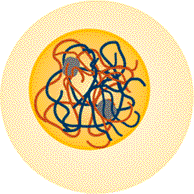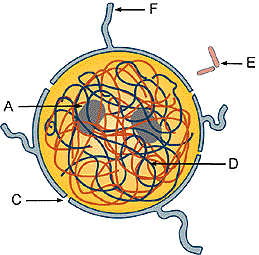
Do your figures resemble the ones below? The figure on the left shows six DNA molecules (three red and three blue) in the form of chromatin (uncondensed and uncoiled). The figure on the right shows the six DNA molecules after they have coiled and condensed to form six chromosomes 3 red and 3 blue). Note that each of the chromosomes are made up of two strands connected near the center. We will discuss this arrangement later. Draw and label these figures in your notes. One chromosome appears as "X".
"sketch (a)"
"sketch (b)"


DNA in the Form of Chromatin
DNA in the Form of Chromosomes
DNA is in uncoiled, uncondensed
DNA is in highly coiled, condensed
state. There are three red lines
state. There are still two sets (red
representing three DNA mole-
and blue) of three chromosomes of,
cules of one set and three blue lines
different lengths. However, each of
representing the the DNA molecules
the six DNA molecules have replicated
of a second set.
but remain attached. This will be
& nbsp;
explained later.
Read the pages indicated by G-2 and study behavioral objective 3. Write in your notes the difference between chromosomes and chromatin.

6. Which the following statements is NOT true concerning the activities of the nucleoid of a prokaryote cell or nucleus of eukaryote cell?
- a) The nucleus controls cellular division in ensure that the daughter cells formed from a single mother cell contains the same number of chromosomes and contains identical genes.
- b) The nucleus controls all cell activities by directing the synthesis of specific enzymes that control the specific activities of that cell.
- c) The nucleus stores and transmits a complete set of heredity information from the mother cell to it daughter cells.
- d) The nucleus contains carbohydrates and lipids used for transmitting genetic information.
In your notes write a paragraph describing the various functions of
the nucleus in relation to cell division, control center for cell activities,
and the storing and transferring of genes.
Click here to go to next page.
For information on how to use this page, go to How
to Use This Site.
Created by the Center for Learning Technologies, Academic Technology Services.
Last modified October 22, 1997.